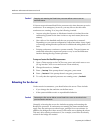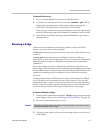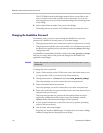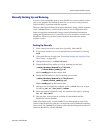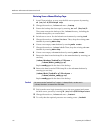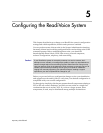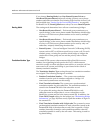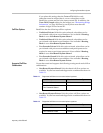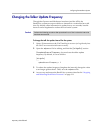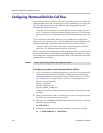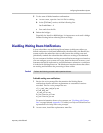
ReadiVoice Administration & Maintenance Guide
120 Proprietary & Confidential
If you change Routing Mode from Non-Routed System Private to
Non-Routed System Shared, delete all existing (private) access phone
numbers and make sure that the Provisioning pages have the Access Code
field available (see “Setting Up the Provisioning Interface” on page 60).
For ReadiVoice IP, Routing Mode must always be set to Routed System.
Routing Mode The routing mode determines how calls are routed among bridges:
— Non-Routed System Shared — Each trunk group terminates on a
specific bridge, so the access phone number determines which bridge
receives a call. Each access phone number can be used by multiple
subscribers.
— Non-Routed System Private — Each trunk group terminates on a
specific bridge, so the access phone number determines which bridge
receives a call. Each access phone number can be used by only one
subscriber, uniquely identifying the subscriber.
— Routed System — Uses an Intelligent Network Call Routing (INCR)
system, such as SS7, to tell the network how to route a call. For each
number group, a routing list specifies which bridge or bridges the
conferences in that group can use and the priority order of those
bridges.
Translation Number Type In a routed PSTN system, when someone dials a ReadiVoice access
number, the originating switch queries the CACS, which returns a
translation number to tell the telephone network how to route the call. In a
non-routed or IP system, each bridge is provisioned with a block of
dummy translation numbers.
The Translation Number Type setting dictates how translation numbers
are assigned. The following settings are available:
— Random Translation Number — The system uses translation
numbers from the pool of numbers assigned to a bridge. All
non-routed systems must use this setting.
— Fixed Translation Number: The system uses a predetermined
translation number for each subscriber. The translation number is
stored in the
ExternalId
field of the subscriber record.
If you select this setting, then the
ExternalId
field for each
subscriber must be unique (that is, no two subscribers on this
ReadiVoice system may have the same external ID). In addition, the
Trans DNIS Length setting for the bridges (see “Maintaining Bridge
Information” on page 18) must exactly equal the number of digits in
the external ID.
— Fixed Translation Number with 3-digit code: The system also uses a
predetermined translation number for each subscriber (stored in the
ExternalId
field of the subscriber record). But it appends a 3-digit
number (internally-formed) to each translation number when the
translation number is used by the call router. This setting is used for
leg-based billing.



